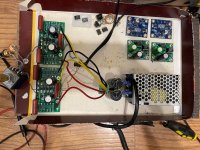I have a Studer 900 Chinese clone @+24VDC. Might I use it to feed this circuit as a line stage?
Thank you,
Gaetano.
bipolar
you need
+/-
The FE2022 can be run with either a single or bipolar supply. if using as a “normal” linestage preamp, you dont need to have enormous voltages. A single supply of 0-24V will work nicely for a linestage.
In the recent example of @tonyEE , his stated application is to drive F4, which IS a time when the large voltage swings are necessary.
I completely agree, however the Vishay that are in the kits are of equal quality, they really are fantastic resistors. Used all over Pass Labs products, look at any online review where there are photos of the PCBs.
In the last couple of years the Dales have been difficult to get in quantity, some values were extremely hard to find or impossible, and are 5x-10x the price. (That adds up very quickly) I really like them as well, but the biggest reason why they were used as our standard wasn’t performance, but because the values are so very easy to read, which keeps stuffing errors down, as well as they are easier to read in photos. But are they necessary to have a top-performing circuit? No.
In the recent example of @tonyEE , his stated application is to drive F4, which IS a time when the large voltage swings are necessary.
I got the complete kit and think it is a great deal, but I do like the look of brown vishay dale
I completely agree, however the Vishay that are in the kits are of equal quality, they really are fantastic resistors. Used all over Pass Labs products, look at any online review where there are photos of the PCBs.
In the last couple of years the Dales have been difficult to get in quantity, some values were extremely hard to find or impossible, and are 5x-10x the price. (That adds up very quickly) I really like them as well, but the biggest reason why they were used as our standard wasn’t performance, but because the values are so very easy to read, which keeps stuffing errors down, as well as they are easier to read in photos. But are they necessary to have a top-performing circuit? No.
The essential kit I got was pretty darn complete. Only the 3.3 and 1000 uF caps were needed to make a 'completion' kit, F4 here I come.The choice of how complete a kit to offer is a calculation of the desires of the DIYer. For example, we often see that "essentials" outsell "completion" kits by something like 2:1, the presumption being that a significant portion want to use their own resistors and capacitors.
^ being that I'm getting back into the groove... I would have preferred to have a complete kit, then I can make substitutions as needed.
Yes, I can read the schematic and build my own BOM... but then I gotta go find them ( yeah, yeah, the putting together the amp seems the easiest part, huh? )...
Yes, I can read the schematic and build my own BOM... but then I gotta go find them ( yeah, yeah, the putting together the amp seems the easiest part, huh? )...
If the FE is solely for the F4, it can be installed in the F4 chassis and powered by the F4 power supply. Or the FE can be in its own chassis and a power umbilical can be taken from the F4 power supply to the FE, ala Quad II and Quad 22.
I want it stand alone. There are other amps.
Do you recall how Audio Research used to have a "gain control" on their preamps? I wonder how easy this would be to do in the FE22... by adjusting the voltage on the power supply... My CJ preamps swing 20 vpp and I always find too much gain going into some amps when driving them with a healthy source...
Dales are perfect for the colorblind among us.
I could resemble that. I was discouraged away from the EE path and went the ME direction.
I completely agree.
…but you should be measuring everything before stuffing anyway, so…
Hello All,
Check them 3 times; when taking the bag out of the orange crate, check them again when taking the resistor out of the bag and check them again with a Fluke DDM when you bend the leads while stuffing them into the PCB.
I have a orange crate full of resistors, mostly Dale RN55 and RN60. They are not all brown or green to my eyes, they may be blue. Each bag of resistors is listed on my spread sheet. Some are purchased surplus as a reel or 1000 at a time or a box of 100 when only 4 are needed for the current project.
I use a RN60 if it will fit and go for the lowest PPM part handy on my stock spread sheet. Because of lower noise and lower measured distortion.
If I can find them I will use Vishay Dale PTF resistors, in terms of noise and distortion they test the best.
Metal foil resistors next to old school carbon resistors are the worst for measured AC distortion. You say why? because they are so light weight the temperature modulates plus minus much more than the larger thermal mass of the typical metal film resistors.
Thanks DT
- Home
- Amplifiers
- Pass Labs
- DIY Front End 2022

